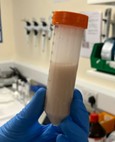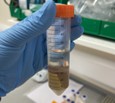QuEChERS guide
What are QuEChERS?
QuEChERS is an acronym which stands for Quick, Easy, Cheap, Effective, Rugged and Safe. It is a very popular sample SPE (solid phase extraction) preparation technique which can be used for a number of sample matrices and analytes for example analysis of residual pesticides in fruits and vegetables. QuEChERS are a highly efficient, cost effective and versatile technique which can be used for a range of applications. The aim of this sample preparation technique is to isolate the target analyte(s) and reduce sample matrix effects.
There are two main steps when using QuEChERS for sample preparation: Extraction and Cleanup. Sample extraction involves using a solvent and a salt mixture to separate the analytes into the organic phase whilst minimising matrix effects. Dispersive solid phase extraction (dSPE) cleanup removes any matrix interferences such as sugars and pigments from sample extract.
Optimising QuEChERS selection
The first step in selecting a QuEChERS method is to understand your sample matrix. It is important to understand if your sample contains water, sugars or fats as well as the pH of the sample.
Water is a key part of QuEChERS extractions as it allows analytes to pass from the sample to the water miscible extraction solvent (commonly acetonitrile). Your samples’ water content must be evaluated to ensure it is sufficient for the extraction which may mean adding water to drier samples. A general rule is that water to extraction solvent should be in a 1:1 ratio. If there isn’t enough water present in your sample then this could lead to an incomplete extraction and poor recoveries. Note that for all samples they must be homogenised before any extraction can begin.
Choosing an extraction salt is crucial for optimising your results. The extraction salt choice determines how efficiently the target analytes will leave the aqueous phase and separate into the organic phase.
There are 3 main types of extraction salts to choose from:
- The original unbuffered method
- Buffered AOAC method
- Buffered European EN method
Choosing between buffered and unbuffered salts should be determined by the pH of the final extract and how pH sensitive the target analytes are. If target analytes are unstable in a certain pH range then by using buffered extraction salts will maintain the ideal pH, ensuring more accurate results.
AOAC salts buffer the final extract to a pH of around 4.75 so a more acidic pH. EN salts buffer the final extract to 5.0-5.5 which is more neutral than AOAC. When using unbuffered salt the pH of the final extract is based on the sample pH.
The next step is to select which clean up is suitable for your sample. There are different sorbent choices and combinations available to effectively clean up your sample by removing excess water and interferences from the extract. Clean up sorbent choice must be selected to maximise contaminant removal whilst not affecting your target analyte(s).
Magnesium sulfate (MgSO4) and primary secondary amine (PSA) is used to remove water, sugars, fatty acids and organic acids which may cause analytical interference. If your sample has a high fat content then using C18 is advised to remove lipids. Graphitised carbon black (GCB) is used to remove pigment from samples.
How to use QuEChERS?
- Weigh 15 g of homogenised sample into a clean 50 mL extraction tube.
- Add 15 mL of 1% acetic acid in acetonitrile (v/v) and any internal standards if being used.
- Add packet of extraction salt for the QuEChERS method chosen to the 50 mL tube.
- Shake vigorously by hand for 1 minute.
- Centrifuge for 5 minutes at >1500 rcf. Phases will separate.
- Transfer 1 mL of acetonitrile extract into chosen clean up tube.
- Shake for 30 seconds by hand and then centrifuge at >1500 rcf for 1 minute.
- Further work up may be required to concentrate sample or change solvent before analysis.
- Transfer sample to vial ready for analysis.





